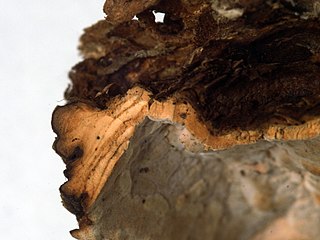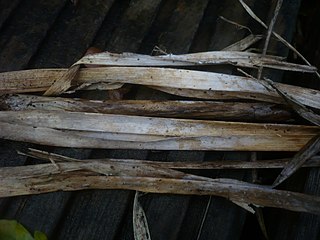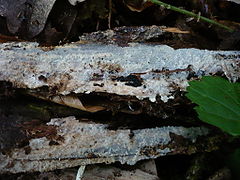
Phanerochaete is a genus of crust fungi in the family Phanerochaetaceae.

The Meruliaceae are a family of fungi in the order Polyporales. According to a 2008 estimate, the family contains 47 genera and 420 species. As of April 2018, Index Fungorum accepts 645 species in the family.

The Phanerochaetaceae are a family of mostly crust fungi in the order Polyporales.

Laurilia is a monotypic genus of crust fungi in the family Echinodontiaceae. The genus was described in 1959 by Czech mycologist Zdeněk Pouzar, with Laurilia sulcata as the type and only species. Pouzar then transferred Laurilia taxodii from Stereum to Laurilia in 1968, but Liu et al. erected the new genus Laurillela for the latter species in 2017 on the basis of ribosomal DNA molecular phylogeny. Liu et al. also found the Echinodontiaceae as traditionally circumscribed to be paraphyletic and placed Laurilia and Lauriliella instead in the Bondarzewiaceae, though this placement is not yet reflected in taxonomic authorities such as the Index Fungorum.

Byssomerulius is a widely distributed genus of crust fungi.
Candelabrochaete is a genus of crust fungi in the family Phanerochaetaceae.

Phlebia is a genus of mostly crust fungi in the family Meruliaceae. The genus has a widespread distribution. Phlebia species cause white rot.

Mycoaciella is a genus of corticioid fungi in the family Meruliaceae. The genus was circumscribed by John Eriksson and Leif Ryvarden in 1978. After microscopic examination of the three species then in the genus, Karen Nakasone proposed to synonymize Mycoaciella with Phlebia.

Mycoacia is a genus of toothed crust fungi in the family Meruliaceae. It was circumscribed by Dutch mycologist Marinus Anton Donk in 1931.

Dacryobolus is a genus of crust fungi in the family Fomitopsidaceae. Elias Fries circumscribed the genus in 1849 with Dacryobolus sudans as the type species. Dacryobolus are wood-decay fungi that cause a brown rot.

Hyphodermella is a genus of crust fungi in the family Phanerochaetaceae.

Cystostereum is a genus of crust fungi in the family Cystostereaceae. The generic name combines the Greek word κύστις ("bladder") with Stereum.
Gloeohypochnicium is a genus of wood-inhabiting crust fungi of uncertain familial placement in the order Russulales. Originally conceived by Erast Parmasto as a subgenus of Hypochnicium, Kurt Hjortstam considered it worthy of distinct generic status in 1987. The type species, G. analogum, was described as new to science in 1913 by French mycologists Hubert Bourdot and Amédée Galzin as a species of Gloeocystidium. G. versatum was added to the genus in 2010.

Hyphoderma is a genus of crust fungi in the family Meruliaceae. It was circumscribed by German botanist Karl Friedrich Wilhelm Wallroth in 1833.

Hypochnicium is a genus of corticioid fungi in the family Meruliaceae. The genus was circumscribed by mycologist John Eriksson in 1958.

Steccherinum is a widely distributed genus of toothed crust fungi in the family Steccherinaceae.
Uncobasidium is a genus of two species of crust fungi in the family Meruliaceae. The genus was circumscribed by mycologists Kurt Hjorstam and Leif Ryvarden in 1978 with the European fungus U. luteolum as the type species. The South American species U. roseocremeum was added to the genus in 2012. The distinguishing feature of Uncobasidium is the basal hook in the basidium.

Dentocorticium is a genus of six species of poroid fungi in the family Polyporaceae. The genus was revised in 2018, with several new species added and some older species transferred to other genera, based on phylogenetic analyses.

Epithele is a genus of crust fungi in the family Polyporaceae.
Fibrodontia is a genus of fungi in the Hydnodontaceae family. The widely distributed genus was circumscribed by Erast Parmasto in 1968. According to Index Fungorum, the type species Fibrodontia gossypina is currently known as Hyphodontia gossypina (Parmasto) Hjortstam.















